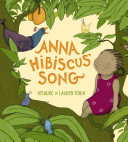
Anna Hibiscus’ Song
Written by Atinuke
Illustrated by Lauren Tobia
Kane Miller, 2011
ISBN:978-1610670401
This picture book tells the story of Anna Hibiscus, a young girl who has lived her entire life in Africa with her immediate and extended family. Her mother is Caucasian and the rest of her family Black. Anna finds herself bubbling with happiness but confused as to how she can express it. She is presented as connected to her culture and comfortable with who she is and with her strong links to family members––her parents, her aunts and uncles. Her extensive extended family nurtures her connections to African culture. The array of diverse characters provides a holistic view of African people and a more authentic representation. Anna is a very happy child who is learning how to express herself. She visits each family member to ask how they express their happiness. She then physically tries each of their expressions in an effort to articulate her own but in the end decides that she can express herself by singing. The song she creates incorporates the ideas from her family.
Anna is a joyful character and a willful little girl whose experiences in a family, culture, and country both connect to and differ from those in western countries. Anna’s mother is presented as Canadian and Anna has a grandmother who lives there. In other stories of her adventures, Anna visits her grandmother and sees Canadian snow for the first time. Atinuke draws on her own family experiences in writing the Anna series, most of which consist of beginning chapter books. Her own mother is from the U.K. and her father is from Nigeria.
Even though the illustrator is not from the culture she depicts it well. The simple but expressive illustrations show Anna and her family as comfortable with each other and their African lifestyle. Her white mother seems to have integrated into the black family and African culture. The illustrations present an uncomplicated lifestyle set in local mango trees as well as the cars and buildings of urbanized Africa. The beginning and ending images are that of a sprawling cosmopolitan city with roads, cars and airplanes. The book opens to an image of the day and closes with the same image at night to represent the passage of time in the life of Anna Hibiscus. The story thus creates a connection between the urban and the rural realities of Africa.
Atinuke was born in Nigeria and spent her childhood in both the U.K. and Nigeria, and now lives in Wales with her family. Her books draw on her ancestry from Yoruba culture, England and Wales as well as the more ancient origins of Spain, Portugal and China to tell stories from the world of folktales and contemporary life. A major critique of her books is that they create a “generic” image of African life and culture rather than depicting Africa as a continent that includes a large diversity of specific peoples, regions, and lifestyles. Her texts usually begin with a statement that repeats over and over, “Anna Hibiscus lives in Africa. Amazing Africa.” Atinuke, however, is adamant in presenting her characters as African in general and not belonging to a particular region of Africa. She chooses to construct a “generic” Africa because of the limited available texts that mirror African cultures. She wants children from a variety of African cultures to be able to find themselves reflected in her books instead of the books being tied to only one specific culture within Africa. She believes that most children’s books reflect images in the media and provide a sensational view of the continent with a focus on AIDS, poverty, hunger, genocide, and violent unrest. Her desire to depict a normal household with normal everyday experiences seems reasonable given the many problematic images of Africa. She does provide an urban setting within her text. This is Atinuke’s first picture book based on the experiences of Anna; her previous books on Anna are short chapter books.
The same thematic threads as this story can be found in other books based on the same character, such as Anna Hibiscus (2007), Good Luck Anna Hibiscus (2011), Hooray for Anna Hibiscus (2008), and Have Fun Anna Hibiscus (2011). Other novels that focus on and portray Africa as an integral part of the characters are The No 1 Car Spotter: Best in the Village-Maybe in the World by Atinuke (2011) and three books by Baba Wague Diakite: The Hatseller and the Monkey (1999), I Lost My Tooth in Africa (2006), and A Gift from Childhood (2010), which are set in Mali. One possibility is to pair Atinuke’s books with books set in specific African countries and cultures so that children don’t develop the stereotype of a generic Africa with no differences across the vast continent.
Seemi Aziz, Oklahoma State University, Stillwater, OK
WOW Review, Volume IV, Issue 4 by Worlds of Words is licensed under a Creative Commons Attribution-NonCommercial-ShareAlike 4.0 International License. Based on work at https://wowlit.org/on-line-publications/review/iv-4/
